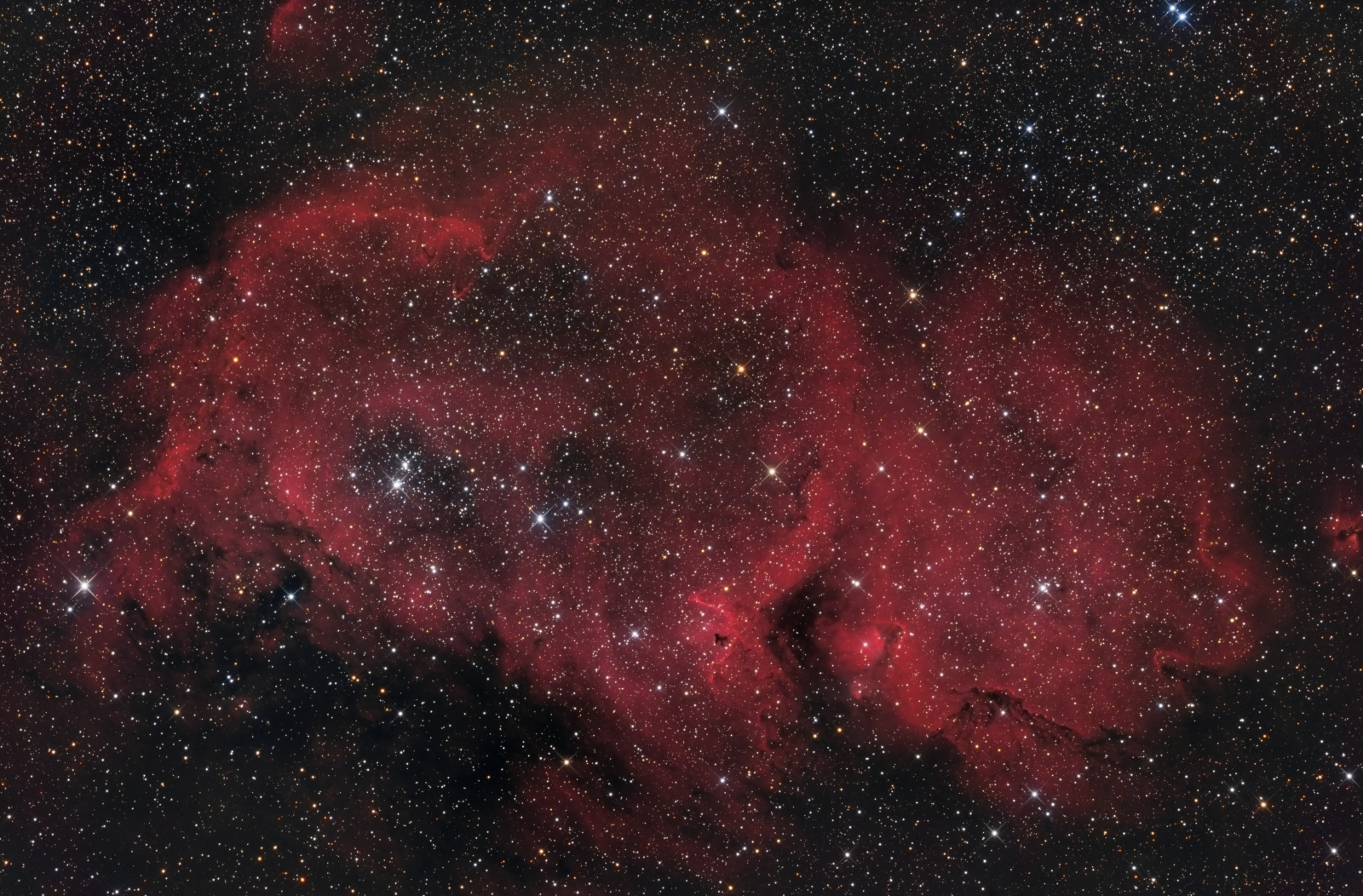The Soul Nebula and IC1848
 Click image for full size version
Click image for full size version
December 12, 2014
This beautiful cloud of glowing hydrogen gas is the Soul Nebula, catalogued as Sh2-199 and LBN667. The nebula looks like a baby (and it is also known as the Baby Nebula), especially if you turn it over. Others see a footprint (maybe we should call it the Sole Nebula?). It lies about 7,500 light years away in Cassiopeia.
In addition to the big nebula that dominates this image, this region is home to numerous open clusters. IC1848 is left of centre, dominated by a pair of bright whitish stars. The “head” contains several clusters from the Collinder Catalogue of Open Star Clusters (CR32, 632 and 634).
Scientifically, the Soul Nebula is a significant object: it provided important evidence for the “triggered star formation theory”. This theory says that older bright stars near the centre push gas atoms outwards and towards each other, causing new stars to form. Analysis of images of the Soul has shown that its oldest stars are near the centre of the nebula, with age decreasing as distance from the centre increases.
The data for this image was acquired in September 2012, but I was never completely happy with the processing until now. I have enjoyed practicing some of the techniques I have learned recently, which are documented below.
Tekkies:
SBIG STL-11000M camera, Baader LRGB filters, 10″ f/3.6 ASA astrograph, MI-250 mount. Guided with STL-11000’s internal guider. Focusing with FocusMax. Acquisition, guiding, calibration, registration and integration all done using Maxim-DL. All other processing in PixInsight. Shot from my SkyShed in Guelph, Ontario. No moon. Average transparency and average seeing.
11x10m of R, G and B and 11x20m Ha for a total of 9hr10m.
HaRGB:
Ha, R, G and B masters were cropped to remove edge artifacts from stacking. The R, G and B channels were combined to make an RGB image. Ha and RGB were processed with DBE, combined with the NB-RGB script, and Colour Calibration was applied. HistogramTransformation was applied, followed by TGVDenoise and another HistogramTransformation to reset the black point.
Synthetic Luminance:
Creation and cleanup: The R,G,B and Ha masters were combined using ImageIntegration tool (average, additive with scaling, noise evaluation, iterative K-sigma / biweight midvariance, no pixel rejection). DBE was applied to neutralize the background.
Deconvolution: A star mask was made to use as a local deringing support. A copy of the image was stretched to use as a range mask. Deconvolution was applied (40 iterations, regularized Richardson-Lucy, external PSF made using DynamicPSF tool).
Stretching: HistogramTransformation was applied, followed by TGV Denoise and another HistogramTransformation to reset the black point. No pixels were clipped during either stretch. The Curves tool was used to boost brightness, contrast and saturation of the nebula.
Combining SynthL with HaRGB:
The luminance channel was extracted, processed and then added back into the HaRGB image as follows:
1. Extract luminance from the HaRGB image.
2. Apply LinearFit using the SynthL channel as a reference.
3. Use ChannelCombination in the Lab mode to replace the luminance of the HaRGB with the fitted luminance from step 2.
4. LRGBCombine was then used to make a SynthLHaRGB image.
Final Processing
Small-scale structures were isolated using MultiscaleLinearTransform (4 wavelet layers, residual layer deselected) on a copy of the SynthLHaRGB image. Large-scale structures were isolated by subtracting the small-scale image from the SynthLHaRGB (no rescaling). A duplicate of the small-scale image was used as a mask on the small-scale image and contrast was boosted. Colour saturation and contrast were boosted on the large-scale image. Then small-scale and large-scale images were added back together in PixelMath. The DarkStructureEnhance script was applied (scale 8, 1 iteration, 0.4 strength). Colour saturation and curves were adjusted slightly.
Image scale is about 2.2 arcsec per pixel for this camera / telescope combination.






Hi Ron,
As usual, I find your image processing details very instructive – my being some distance behind you on the Pixinsight learning curve!
I like the shape and detail in this image. Very nice.
Mark
PS: I’m in the process of working up my ASA10 in the f/2.75 mode. Hope to have a ‘first light’ image processed shortly. This focal length works well with my camera – giving 89′ X 67′ fov, and the speed is great!